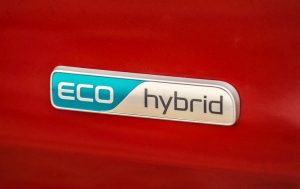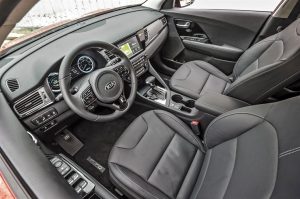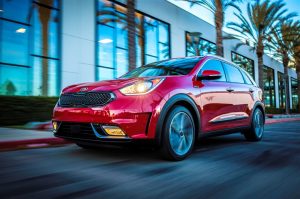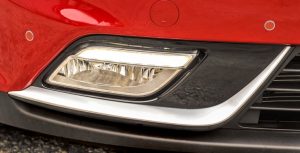A Stealth Hybrid, Quasi-SUV
Kia is marketing the 2017 Kia Niro as a crossover SUV, even though some pundits say it’s more of a tall wagon or a five-door hatchback. It’s not available with all-wheel drive. Ground clearance is comparable to that of most cars, and the 23.1-inch seat height falls between cars and crossovers.

But the Korean automaker isn’t messing around with its first ever dedicated gasoline-electric hybrid, even though Kia rarely mentions the hybrid powertrain. The Niro promises much: up to 50-mpg combined with the most frugal FE (for Fuel Efficient) trim level. The top-end Niro Touring is EPA rated at 43-mpg, while the midrange LX and LE trim levels register a 49-mpg combined rating. Kia parses the Niro into three separate EPA certifications in order to get a bigger number for the lighter, lower-spec trims.
Given America’s strong and growing preference for SUVs, Kia is not only wise to position the Niro as a crossover with exceptional fuel economy, but also with very alluring prices—the only hybrids carrying lower base prices are the new Hyundai Ioniq hybrid and the very small Toyota Prius c.
Looking Through the Lineup
A look at the lineup starts with the Niro FE, which starts at $22,890. It comes standard with a tilt-and-telescopic steering wheel, a six-speaker sound system, a rearview camera, Bluetooth, a USB port, cloth upholstery and 60/40 split folding rear seats. Kia’s UVO infotainment system is also standard and includes a seven-inch touch screen, Apple CarPlay, Android Auto and satellite radio.

Next up, the Niro LX has a starting price of $23,200. It adds push-button start and offers the LX Advanced Technology package for $1,450. It adds things like autonomous emergency braking and forward collision warning.
This is followed by the Niro EX at $25,700. Added are heated outside mirrors, leather trim, heated front seats and a leather-wrapped steering wheel, blind spot monitoring, lane change assist, rear cross traffic alert and a rear USB port. A $2,300 package adds features like a sunroof and adaptive cruise control.
The top-end Niro Touring is priced starting at $29,650. It comes with lower-trim features and adds leather upholstery, ventilated front seats, a heated steering wheel, a sunroof, and front and rear park assist. A $1,900 Touring Advanced package offers features such as a wireless phone charger, lane departure warning, and a forward collision warning system.
On The Road
The 2017 Kia Niro is rather impressive underneath, using an all-new platforform developed exclusively for electrified vehicles shared with parent company Hyundai’s Ioniq Hybrid and EV cars. Kia’s hybrid powertrain is relativly simple, with a single 43-horsepower electric motor/generator incorporated into the six-speed dual-clutch automatic transmission and a 1.56-kilowatt-hour lithium-ion polymer battery pack.

Like other hybrid systems, the electric motor can power the Niro by itself or team up with the high-compression Atkinson cycle 1.6-liter four-cylinder engine that produces 104 horsepower and 109 pounds-feet of torque. In tandem, the gasoline engine and electric motor have an output of 139 horsepower and 195 pounds-feet of torque.
Seats on our Niro Touring test car were just high enough to make entering and exiting the vehicle easy and, once seated, provided a high enough position to give a good view of traffic ahead. It wasn’t quite the height of most small SUVs, but better than a normal sedan.
As I eased out of our driveway, the Niro was silent up to 12 mph, when the gas engine joined in. It was a seamless addition that was only noticed by a small amount of engine noise. I increased speed to around 40 mph, briefly lifted my foot, then eased on the accelerator, and the little SUV began to cruise along on electric power only for nearly three miles, at which point I came to a stop sign. From there on it was easy to drive in town under electric power.
In the Mode
Most hybrids take a little time to get used to, primarily because of the way continuous variable transmissions (CVT) operate. Kia takes care of that by employing a six-speed dual-clutch automatic transmission, which unobtrusively and quickly went through the gears just like a traditional car. I drove the Niro mostly in Eco mode, which controls parts of the hybrid and climate control systems to achieve optimal fuel economy.
In Eco mode, starting up from a stop is like a slow moving conventional car. A switch to Sport mode made it difficult to remember that the Niro was a hybrid vehicle. That remained true even on the highway, although Sport mode had the penalty of reduced fuel economy.
Kia made it easy to not only track my fuel economy, but also the operation of the hybrid system. There’s an Energy Flow diagram in the instrument cluster and on the central touchscreen with a minute-by-minute fuel economy graph and a Charge/Eco/Power meter that replaces the tachometer in the instrument cluster. The display also included a tree whose leaves gradually added or lost color—while or shades of blue—based on my driving habits.
As for in town driving, the Niro’s bluff shape and short overhangs made it an excellent urban car. The turning circle was impressively tight, and its boxy shape made it easy to get in and out of in tight spots. The Niro Touring proved itself well in city driving, surpassing the EPA’s 46 mpg rating with 49.4 mpg shown on the onboard readout.

With a zero to 60 mph time of just under nine seconds, merging into fast-moving freeway traffic was best accomplished in Sport mode. Once settled in, Eco mode was adequate to keep up with the 75 mph flow. The Niro delivered a pleasant ride, soaking up mundane blacktop and concrete patches, cracks and expansion joints rather gracefully. Steering and handling mostly mimicked that of a car with controlled body roll, while brakes had a firm, confident feel. Of note, the Smart Cruise Control was one of the best we’ve used. It didn’t overreact when a vehicle moved into our buffer, and it kept a tight gap in slow-and-go traffic.
Our week of driving the Niro totaled 253 miles, with a combined fuel economy of 44.7 mpg, again better than the EPA’s estimate of 43 mpg combined.
Niro Styling
Regardless of the 2017 Kia Niro not having all-wheel drive, my view is any way you slice-and-dice the styling, it is reflective of a small crossover SUV. The Niro is a traditional two-box SUV design. It blends a lower height and wide stance with a four-door body that has a vertical rear tailgate.

Up front, swept-back headlights bookend Niro’s version of Kia’s new wide “tiger nose” grille, while a sporty rear theme is enabled by the wide stance, rugged-looking rear skid plate and multi-element horizontal LED tail lamp graphic. Black-outlined wheel arches, rocker-panel cladding and roof rails complete the SUV look.
Kudos to Kia designers who carefully crafted an aerodynamic body that brags a 0.29 drag coefficient. That’s low for any kind of utility vehicle, and undoubtedly contributes to its fuel-economy ratings at higher speeds.
The Kia Niro seats five and offers comfortable and supportive seats, even on long journeys. There is plenty of leg and headroom in both the front and rear seats, even for taller adults, although three is a crowd in the rear seats.
Inside, a clean design impresses. Kia has become a class leader in using quality materials that are perfectly fitted, and the Niro shows off this distinction. The instrument panel is uncluttered and clean, with colorful and informative gauges at the forefront and perfectly positioned primary and secondary controls falling readily to hand. Buttons and knobs all feel like they were designed, engineered and manufactured with attention to detail.
Kia’s UVO infotainment system, with an eight-inch touch screen, real-time traffic conditions, and a voice-command navigation system, is intuitive to use and offers vivid graphics. Apple CarPlay and Android Auto are standard, as is Bluetooth connectivity.
Rear doors open wide to aid in the fitting of child seats, which are easy to install. Cargo space is an adequate 19.4 cubic feet with the rear seats in use. Located beneath the Niro’s load floor, a compartmentalized storage area helps to organize things. Fold the rear seats, and a cavernous 54.5 cubic feet of space becomes available.
In The Marketplace
There’s a bushel basket full of 2017 subcompact crossover SUVs to choose from, but none offer the fuel efficiency of the Niro. Through July, leading the pack is Jeep’s Renegade, which I recently reviewed. There are a variety of trim levels to choose from, including the four-wheel drive Renegade Trailhawk that is the king of tackling rugged off-road trails.

Next up is the Honda HR-V. It is offered with all-wheel drive, but the Niro has a longer list of standard features, Android Auto and Apple CarPlay. The Niro also comes with more available advanced safety features, such as a forward collision warning system. Features like these aren’t even available in the HR-V’s top trim.
The HR-V is followed by the Subaru XV Crosstrek, which comes standard with all-wheel drive, but doesn’t come close to the Niro’s fuel economy numbers. Then there’s the Mitsubishi Outlander Sport, Buick Encore, Chevrolet Trax, Mini Countryman and Mazda CX-3 that are all vying for your attention.
Kia didn’t release the 2017 Niro for sale in the U.S. until January 2017, yet through July it was the third best-selling hybrid vehicle, following only the Toyota Prius Liftback and Toyota RAV4 Hybrid, and the latter is only offered with all-wheel drive.
Apparently, promoting the 2017 Niro’s fuel economy without mentioning it’s a hybrid has hit a chord with American buyers. You should check it out.
In order to give you, the reader, the best perspective on the many vehicles available, Clean Fleet Report has a variety of contributors. When possible, we will offer you multiple perspectives on a given vehicle. This comes under SRO-Second Road Test Opinion. We hope you’ll enjoy these diverse views–some are just below—and let us know if you do or don’t at publisher@cleanfleetreport.com.
Road Test: 2017 Kia Nio (Steve’s View)
Road Test: 2017 Kia Niro (John’s View)
First Drive: 2017 Kia Niro
Related Stories You Might Enjoy
Road Test: 2017 Jeep Renegade
Road Test: 2016 Honda HR-V (John’s view)
Road Test: 2016 Honda HR-V (Larry’s view)
Road Test: 2013 Subaru Crosstrek
Road Test: 2017 Mitsubishi Outlander Sport
Road Test: 2015 Buick Encore
Road Test: 2015 Chevrolet Trax
Road Test: 2017 Mazda CX-3
Road Test: 2016 Toyota Prius Liftback
Road Test: 2016 Toyota RAV4 Hybrid
Disclosure:
Clean Fleet Report is loaned free test vehicles from automakers to evaluate, typically for a week at a time. Our road tests are based on this one-week drive of a new vehicle. Because of this we don’t address issues such as long-term reliability or total cost of ownership. In addition we are often invited to manufacturer events highlighting new vehicles or technology. As part of these events we may be offered free transportation, lodging or meals. We do our best to present our unvarnished evaluations of vehicles and news irrespective of these inducements.
Our focus is on vehicles that offer the best fuel economy in their class, which leads us to emphasize electric cars, plug-in hybrids, hybrids and diesels. We also feature those efficient gas-powered vehicles that are among the top mpg vehicles in their class. In addition, we aim to offer reviews and news on advanced technology and the alternative fuel vehicle market. We welcome any feedback from vehicle owners and are dedicated to providing a forum for alternative viewpoints. Please let us know your views at publisher@cleanfleetreport.com.

12 thoughts on “Road Test: 2017 Kia Niro Hybrid”